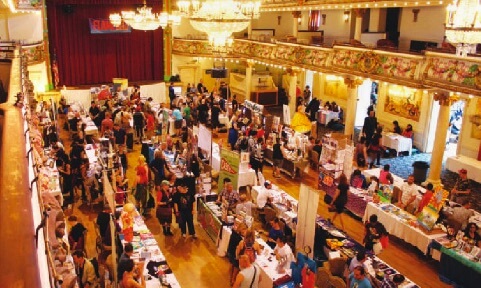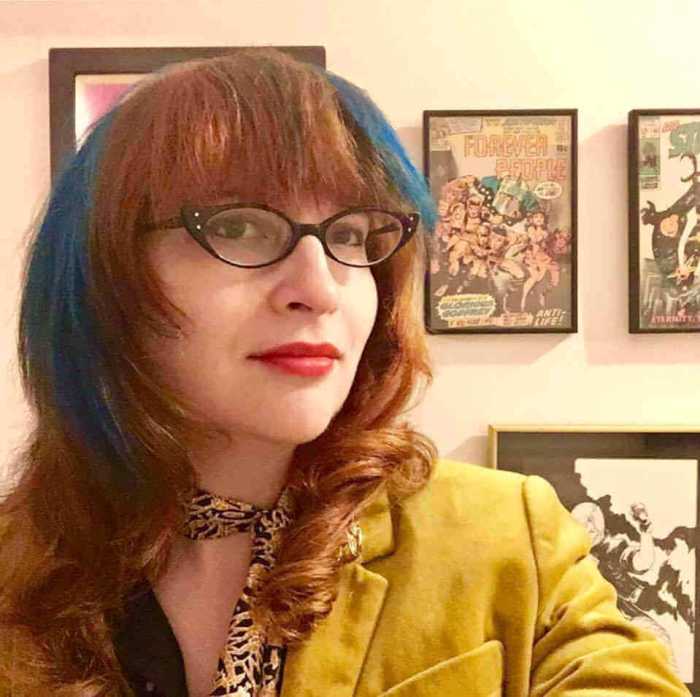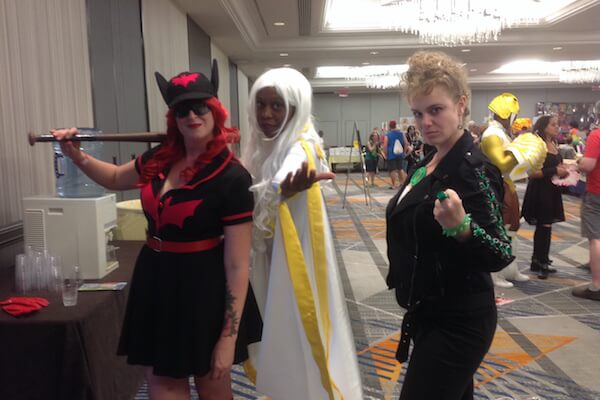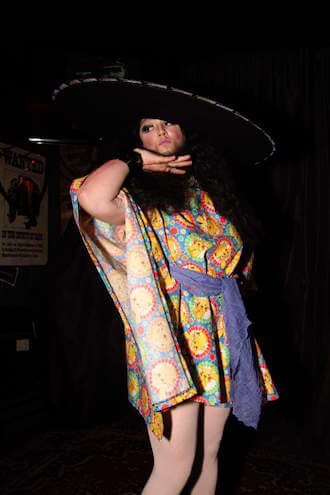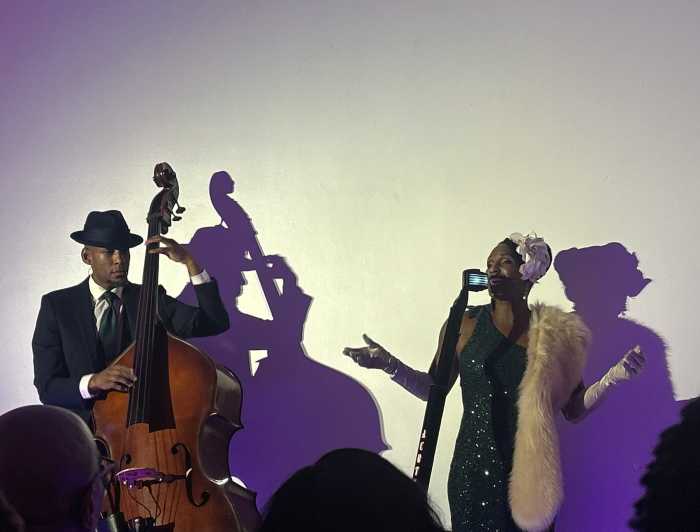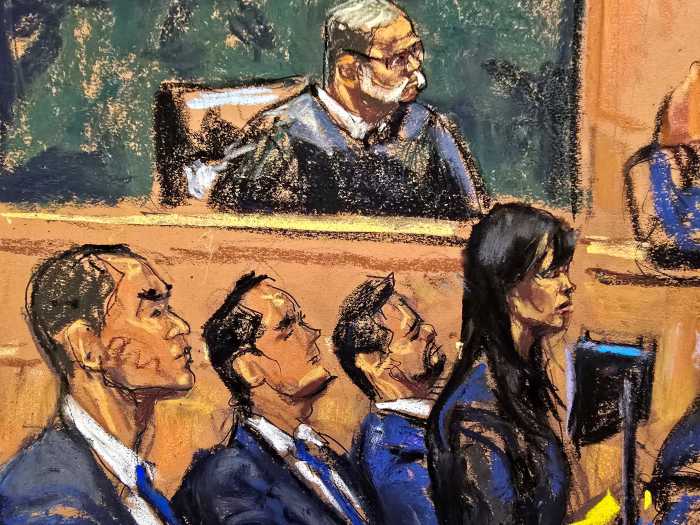Flamey, the Flame Con mascot, joins cosplay costume contest winners. | FWEE CARER/ COURTESY: FLAME CON
BY CHARLES BATTERSBY | In decades past, geek media like comic books and video games avoided direct mention of LGBT themes. While Geek media was often seen as childish, LGBT representation was viewed as inherently sexual and unsuitable for kids. In recent years, a new generation of gay and transgender creators have begun making their own comics and games, while publishers have embraced a new audience and presented a more diverse roster of characters. The stereotypes of both subcultures are being eroded by the arrival of these openly LGBT geeks.
Industry conventions like Comic Con present panel discussions where publishers promote upcoming projects, but the cons also have panels on more esoteric topics, including LGBT themes. Previously, a major con might have had a single panel devoted to “Diversity” — but the cons of today have multiple panels that address topics of interest beyond the stereotypical straight white male nerd. Gay geeks have proliferated so much that there have been several cons that cater specifically to them.
Gaymer X is a West Coast event that is geared toward video game fans, and will see its third annual installment this winter. In New York City there is Flame Con, which had its first incarnation earlier this month at the opulent Grand Prospect Hall in Brooklyn. It celebrated all manner of geek culture and hosted a dedicated lounge for gamers, along with a show floor for comic book artists and vendors. Panel discussions were held on a variety of gay-specific topics, including kid-friendly gay comics, gay themes in the horror genre, and gay “anti-hero” characters that defy the traditional do-gooder image.
As comicdom’s LGBT era unfolds, Flame Con offers a place for cosplay and transgender fans
Comic book conventions have seen a drastic increase in another subculture recently: cosplay — fans who dress up as their favorite characters, often with elaborate handcrafted clothing and props. Flame Con was no exception, with numerous attendees dressed as flamboyant interpretations of film, comic, and game characters. Even at mainstream conventions, cosplay has become a safe way to explore identity, and it is quite common for fans to “crossplay” as characters of the opposite gender.
Even as the push for LGBT inclusivity in the nerd community gained steam a few years ago, the “T” for transgender was often an afterthought — or overlooked altogether in panels where all the speakers were cisgender. But several recent major conventions have taken the step of presenting programming that looks exclusively at transgender themes (several of which I organized and moderated).
New York’s Special Edition: NYC convention hosted such a panel in 2014, and the San Diego Comic-Con followed suit later that summer, as did the New York Comic-Con that fall. Within the span of a week this June, New York City saw panels about transgender comic book characters at two conventions — Special Edition: NYC, as well as Flame Con.
The main floor Flame Con exhibitors at Brooklyn's Grand Prospect Hall. | MICHAEL SHIREY
One of Flame Con’s panelists, P. Kristen Enos, the writer of “Web of Lives,” pointed out, “While panels on transgender themes feel like a novelty in a standard geek convention, there’s no way Flame Con could be taken with any credibility if their first con did not have a panel like this, and I’m glad that they did, and that I could be part of it. The audience already felt educated about the issues of transgender presentation that it allowed us as panelists to talk about topics deeper and further than at a standard convention.”
Also a panelist at Flame Con, Jennie Wood — writer of the comic “Flutter” and the novel “A Boy Like Me” — said, “At one point I sat back during the panel and thought to myself, ‘Wow, what an honor to be here with such talented, wonderful, thoughtful people.’ There was such a warm vibe in the room…from my fellow panelists, our moderator, and the audience. And there was a level of maturity to the discussion that can sometimes be lacking on panels.”
There have been too many transgender characters and stories to name them all in one article, but many of them follow recurring patterns. Back in the Golden Age of the ‘30s and ‘40s, comic books would address themes of gender-change — but only for plot purposes. Heroes and heroines would frequently disguise themselves as persons of the opposite gender, usually as part of contrived situations to dupe foolish enemies. One character in particular, Madame Fatal, was based entirely around this concept. She was a young man who disguised himself as a little old lady in order to lull enemies into false security.
In the decades since, characters ranging from Captain America to Jimmy Olsen and even Batman have used this gimmick in their stories. It was usually played for laughs, but sometimes was depicted seriously (to prove that certain characters were true masters of disguise). On occasion, female characters would disguise themselves as male in order to appear more threatening. These characters weren’t truly transgender, although the stories might have unintentionally resonated with trans readers.
Another long-standing use of gender change as a plot device is having a character cursed by being transformed into the other gender. In geek media, the writers are free to use outlandish science or magic to accomplish this. Characters would have their gender changed forcibly, often in an effort to tell stories about sexism, but these stories inadvertently overlooked the opportunity to address the trans experience of feeling trapped in a body of the wrong gender.
It was rare that a comic character willingly changed gender until the late ‘80’s rolled around and comic books entered their “dark & gritty” phase. The readers had grown up, and the comic industry took its first tenuous steps into transgender representation with adult-oriented comics published by the same mainstream companies that made Superman and Spider-Man.
However, this new generation of transgender characters generally consisted of supporting characters and rarely had their own set of super powers or fought evil on their own. A notable exception was Coagula of “Doom Patrol,” who was a male-to-female trans who gained the power to turn solid objects into fluids, and vice versa (a deliberate metaphor for gender fluidity).
A more recent example of a transgender super hero is Sera in the series “Angela: Asgard’s Assassin.” She appeared with little fanfare a few months ago, and readers didn’t even know that she was trans until three issues into her story. Marguerite Bennett, who wrote Sera’s sub-story within this storyline, was a panelist at both Flame Con and Special Edition: NYC, where she discussed the character. Sera was born in a male body, in a society where only women can become warriors. She eventually “found a way to make me myself” and became a magical swordswoman who has been incorporated into Marvel Comics lore, fighting alongside Thor and the Guardians of the Galaxy.
The video game industry is relatively young compared to comics, and it has only recently been accepted by the general public as a narrative art form. For decades, games used the same plot device involving gender themes — including curses and disguises — seen in other geek media. As players and game developers became increasingly diverse, however, the industry responded.
The “Saints Row” franchise has several installments that allow players to take their character to a cosmetic surgeon to change gender in mid-game, or even create a character who is gender non-conforming right from the start. Last year’s “Dragon Age: Inquisition” featured a subplot in which one of the supporting characters, Krem, is female-to-male trans and comes from a culture where it is accepted. A few long-running franchises like “Mario” and “Street Fighter” have transgender characters among their casts as well, and have garnered a cult following for the characters Birdo and Poison.
Two decades ago, the notion of a transgender geek would have been seen as a paradox. However the sci-fi/ fantasy settings of games and comics have allowed writers and designers to address gender identity in ways that more realistic settings can’t. The blossoming transgender community among nerds has also proven to be an unexpected safe place for trans people to find kindred spirits, while sharing their love of superheroes and epic adventure.

